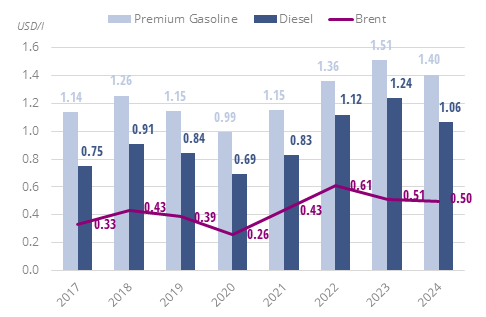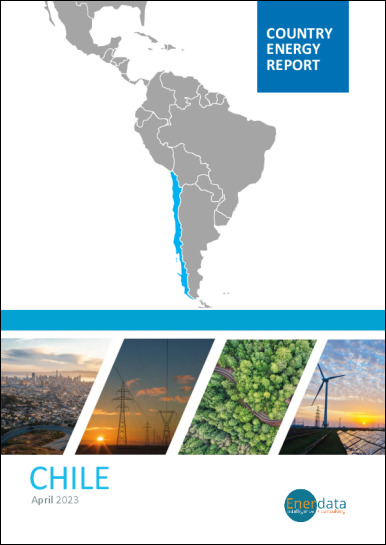- Update
-
- Format
- 4 files (PDF report, 3 Excel files)
- Pages
-
66 (Report only)
- Delivery
- Immediate by e-mail
- GENERAL OVERVIEW
- ENERGY AND CLIMATE POLICY FRAMEWORK
- ENERGY COMPANIES
- ENERGY SUPPLY AND DEMAND
- ENERGY USE AND PRICE BY SECTOR
- ISSUES AND PROSPECTS
- STATISTICS
- ABBREVIATIONS
- GLOSSARY
Buy Chile energy report
Price without VAT. Depending on your statute and location, VAT might be applicable. Get in touch with us for more information.
After validation, you will immediately receive 4 files by email (one pdf report and 3 excel files containing the datasets).
Overview
Chile is advancing an ambitious energy transition, targeting 80% renewable electricity by 2030 and carbon neutrality by 2050. Key measures include phasing out coal, expanding solar and wind capacity, and developing green hydrogen, supported by regulatory reforms and public-private partnerships.
Get more details on the table of contents and data files, as well as the list of graphs and tables by browsing the tabs below.
Highlights
- Chile targets a share of 80% of renewables in the power mix in 2030 and zero-emissions in 2050.
- Around 40% of the coal capacity will be closed by 2025, with a total phase-out in 2040.
- Enel is the largest power company, with around 40% of power generation and half of the distribution.
- Around 12 GW of solar and wind were commissioned between 2019 and 2024.
- The share of renewables in the power mix has increased rapidly since 2019 (+19 points), reaching 59% in 2024
- Final energy consumption has remained roughly stable since 2022.
- Industry absorbs almost 60% of the electricity consumption.
- Around 9 GW of wind and solar projects are under construction.
Energy & Climate Policy Framework
The Ministry of Energy is responsible for energy policy and planning.
The Environment Ministry is in charge of climate change.
Energy Companies
Gas:
ENAP produces gas in the south of Chile.
GNL Quintero is the operator of the largest LNG terminal, with a capacity of 5.5 bcm/year. It associates EIG and Fluxys (40% each) and ENAP (20%). EIG and Fluxys jointly acquired an 80% equity stake in GNL Quintero from Enagas Chile (45%) and affiliates of Omers Infrastructure (35%) in 2022.
Energy Supply & Demand
Resources:
Chile's fossil fuel resources are scarce: their reserves are estimated at 20 Mt for oil, 10 bcm for gas and 1.3 Gt for coal (end of 2023).
Energy Use and Price by Sector
Energy Prices in Transport:
Motor fuel prices follow international prices. They decreased in 2024, reaching US$1.4/l for gasoline (-7%) and US$1.2/l for diesel (-14%).
Graph: Energy Prices Including Taxes in Transport

Issues & Prospects
Chile's Energy Roadmap for 2050 targets a zero-emission power mix (mainly solar and wind) and a shift from private to public transportation which, according to the plan, should be low or non-carbon-emitting by 2050. New environmental standards, the promotion of energy efficiency and the eradication of energy poverty are also considered in the roadmap.
- Graph 1: Primary Intensity to GDP
- Graph 2: Primary Consumption Trends by Energy Source
- Graph 3: Total Consumption Market Share by Energy (2024)
- Graph 4: Installed Electric Capacity by Source
- Graph 5: Installed Electric Capacity by Source (2024)
- Graph 6: Gross Power Production by Source & Consumption
- Graph 7: Power Generation by Source (2024)
- Graph 8: CO2 Intensity of Electricity Generation
- Graph 9: Crude Oil Production & Consumption
- Graph 10: Petroleum Products Production & Consumption
- Graph 11: Gas Production & Consumption
- Graph 12: Coal Production & Consumption
- Graph 13: GHG Emissions and CO2-energy Emissions
- Graph 14: CO2-Emissions per Capita
- Graph 15: CO2 Intensity to GDP
- Graph 16: Final Demand Trends by Energy Source
- Graph 17: Final Consumption by Sector
- Graph 18: Final Consumption Market Share by Sector (2024)
- Graph 19: Share of Electricity in Total Final Energy Consumption
- Graph 20: Final Consumption in Industry by Energy Source
- Graph 21: Energy Prices Including Taxes in Industry
- Graph 22: Final Consumption in Transport by Energy Source
- Graph 23: Energy Prices Including Taxes in Transport
- Graph 24: Final Consumption in Residential, Services, Agriculture by Energy Source
- Graph 25: Energy Prices Including Taxes in Residential
- Graph 26: Upcoming New Capacity by Energy Source
- Economic Indicators: Annual historical data including population, GDP growth, imports and exports, inflation rate, energy security and efficiency indicators, CO2 emissions.
- Supply Indicators: Historical data including oil and gas reserves, electric and refining capacity, energy production, power production and external trade. All are detailed by energy source.
- Demand Indicators: Historical data including consumption per inhabitant, consumption trends, total consumption by energy source, final consumption by energy source and sector, and electricity consumption by sector.
- Energy Balances: Single table displaying the overall energy industry balance per annum, also graphically displayed by energy sub-segment.
The Chile energy market data since 1990 and up to
is included in the Excel file accompanying the Chile country report.
It showcases the historical evolution, allowing users to easily work with the data.
Key Data included in the excelsheet:
- Economic indicators: Annual historical economic indicators, energy security, energy efficiency and CO2 emissions.
- Supply indicators: Annual historical reserves, capacity, production and external trade (imports(+) exports(-) balance).
- Demand indicators: Annual historical consumption per capita, consumption trends, total consumption, final consumption (per energy and per sector) and electricity consumption total and per sector.
- Energy Balance: total and per energy.
- Chile Energy Prices: In addition to the analysis provided on the report we also provided a data set which includes historical details on the Chile energy prices for the follow items: price of premium gasoline (taxes incl.), price of diesel (taxes incl.), price of electricity in industry (taxes incl.), price of electricity for households (taxes incl.), price of natural gas in industry (taxes incl.), prices of natural gas for households (taxes incl.), spot price of Brent and CO2 emissions (from fuel combustion).
The Chile country dashboards are complemented with country forecasts from EnerFuture (excel file) with scenario comparison.
Data included in the excelsheet:
- Demand: Primary energy consumption, final energy consumption, by fuel, by sector.
- Power: Electricity generation & capacities, by technology.
- CO2: Total CO2 emissions.
- Macro-economy: Main macro-economic assumptions.
- Key indicators: Energy intensity, share of renewables, CO2 emissions per capita and per unit of GDP.
 Energy and Climate Databases
Energy and Climate Databases Market Analysis
Market Analysis